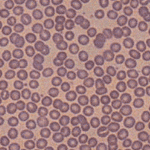 |
| Normal blood smear |
Leukemia is a type of cancer in which abnormal white blood cells grow in an uncontrolled manner. The white blood cells divide, multiply, and then spread out of control. This interferes with the production of normal blood cells.
Understanding how normal blood cells are formed offers greater insight into leukemia. Most blood cells are formed in the bone marrow and by the other organs in the lymph system. The marrow is the soft, sponge-like center of large bones. In the marrow of a healthy person marrow, very young cells called stem cells multiply and mature into three types of cells: white blood cells, red blood cells, and platelets. Each type has a specific job to do in the body.
White blood cells fight infection by destroying bacteria and viruses that invade the body.
Red blood cells carry oxygen from the lungs to all parts of the body.
Platelets help form blood clots, which control bleeding when a person is injured.
Click here to see the blood cells produced in the bone marrow
The lymph system consists of the bone marrow, lymph nodes, spleen, thymus, and tonsils. This system produces B-and T-lymphocytes (types of white blood cells). The B-lymphocytes fight infection by making substances called antibodies, which attack germs in the body. T-lymphocytes help to destroy invading organisms as well as cancer cells.
In leukemia, the marrow produces too many immature or abnormal white blood cells. As a result the leukemia cells crowd out the marrow and leave very little space for the normal blood cells to grow. Consequently, the number of healthy blood cells drops, and causes frequent infections, anemia, and bleeding problems.
This year about 31,500 Americans will be diagnosed with leukemia, including 28,800 adults and 2,700 children, and approximately 21,500 persons will die of leukemia. The chances of survival depend on the type of leukemia, the age and health of the person, and the medical treatment one receives. An average of 65% of people with leukemia survive for one year after diagnosis. This rate drops to about 44% five years after diagnosis.
Leukemia is grouped in two ways. One way is by the type of white blood cell that is affected. The other way is by how quickly the disease develops and worsens. This grouping is important because the speed with which leukemia progresses and the types of therapy that are given vary.
There are two main types of white blood cells: granulocytes and lymphocytes. Leukemia involving granulocytes is called myeloid or myelogenous leukemia. Leukemia involving lymphocytes is called lymphocytic leukemia.
Leukemia can be either acute or chronic. Acute leukemia progresses quickly with many immature cells. Chronic leukemia progresses slowly with more mature, normal looking cells.
The two ways of grouping leukemia usually results in four main types of leukemia:
 |
Acute myelogenous leukemia (AML) is a common leukemia in adults from the ages of 50 to 70 years old. It is also called acute nonlymphocytic leukemia (ANLL). Acute promyelocytic leukemia, a subtype of leukemia, is associated with bleeding disorders. |
 |
Acute lymphocytic leukemia (ALL) is the most commonly diagnosed in children under the age 10, but it also affects adults of ages 65 and older. Most ALL cases involve B-cell lymphocytes. The good news is that the 5-year survival rate of ALL has dramatically improved from 38% in the mid-1970s to 60% in the late-1990s. Survival rates for children with ALL have increased from 54% to 82% over the same period. |
 |
Chronic myelogenous leukemia (CML) occurs mainly in adults from 50 to 70-year-old, but a small number of children may get CML. People with CML usually have a mutated gene called the "Philadelphia" chromosome where a part of one specific chromosome is attached to a different chromosome. |
 |
Chronic lymphocytic leukemia (CLL) usually affects older adults and can run in families. Persons with CLL may feel well for years without treatment. |
Click here to see the table |